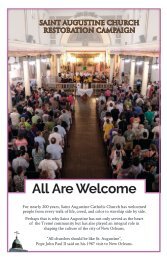Saint Augustine Church Restoration Campaign _ Sponsorship
St. Augustine Church was built in 1841, making it 178 years old this year. The structure is so compromised that it leaves her vulnerable to storms, decay, and other conditions that may result in the closing of her doors forever and is in dire need of major renovations. The St. Augustine Church Restoration Campaign is the first Church’s first-ever effort to restore the church and rectory buildings. St. Augustine Church is known for its’ congregation of all races, Free People of Color, slaves, whites, Haitians, Cubans, Italians, Germans, etc. from its inception in 1841, till today and as the nation’s oldest black Catholic parish, it is part of the permanent exhibits in the Smithsonian’s new National Museum of African American History and Culture in Washington, D.C. Considered the oldest black neighborhood in America, and the oldest African American Church in the country, it was home to the first civil rights movement, the first black daily newspaper, black businesses and was deeply rooted in the development of the music culture and parading history of New Orleans which came out of Tremé.
St. Augustine Church was built in 1841, making it 178 years old this year. The structure is so compromised that it leaves her vulnerable to storms, decay, and other conditions that may result in the closing of her doors forever and is in dire need of major renovations. The St. Augustine Church Restoration Campaign is the first Church’s first-ever effort to restore the church and rectory buildings.
St. Augustine Church is known for its’ congregation of all races, Free People of Color, slaves, whites, Haitians, Cubans, Italians, Germans, etc. from its inception in 1841, till today and as the nation’s oldest black Catholic parish, it is part of the permanent exhibits in the Smithsonian’s new National Museum of African American History and Culture in Washington, D.C.
Considered the oldest black neighborhood in America, and the oldest African American Church in the country, it was home to the first civil rights movement, the first black daily newspaper, black businesses and was deeply rooted in the development of the music culture and parading history of New Orleans which came out of Tremé.
Create successful ePaper yourself
Turn your PDF publications into a flip-book with our unique Google optimized e-Paper software.
From the beginning St. <strong>Augustine</strong>’s<br />
origins lie in the initiatives of New<br />
Orleans’ people of Tremé on land<br />
donated by the Ursuline Sisters.<br />
who took over the school and merged it<br />
with their school for white girls and used<br />
the Tremé home for their mother house<br />
until 1926.<br />
From the beginning St. <strong>Augustine</strong>’s<br />
origins lie in the initiatives of New<br />
Orleans’ people of Tremé. In the 1830’s<br />
Tremé’s Free People of Color petitioned<br />
Bishop Antoine Blanc for permission to<br />
build a church. The Ursuline Sisters, who<br />
owned the property adjacent to the school,<br />
donated a lot at the corner of Bayou Road<br />
(Gov. Nicholls St.) and <strong>Saint</strong> Claude,<br />
(Henriette Delille St.) on the condition<br />
the church would be named <strong>Saint</strong><br />
<strong>Augustine</strong>, after one of their patron saints.<br />
St. <strong>Augustine</strong> <strong>Church</strong> began construction<br />
in 1839, where fourteen Free People of<br />
Color placed the church’s capstone. The<br />
church was dedicated in 1841.<br />
A few months before the October<br />
9, 1841 dedication of <strong>Saint</strong> <strong>Augustine</strong><br />
<strong>Church</strong>, the Free People of Color began<br />
to purchase pews for their families. Upon<br />
hearing of this, white people in the area<br />
started their campaign to buy pews, thus<br />
the “War of the Pews” began. The white<br />
and Free People of Color each purchased<br />
the center pews. In an unprecedented<br />
political and religious move, the Free<br />
People of Color members bought all the<br />
side aisle pews. They then gave those<br />
pews to the slaves as their exclusive place<br />
of worship. This mix of pews resulted<br />
in the most integrated congregation in<br />
the country. It is the oldest church in the<br />
United States that has had a continuous<br />
mixed congregation of Free People of<br />
Color, slaves and whites throughout its<br />
entire history; many ethnicities found<br />
spiritual comfort at <strong>Saint</strong> <strong>Augustine</strong><br />
<strong>Church</strong>. White children and black and<br />
every shade in between knelt side by side.<br />
Black and whites sang side by side in the<br />
choir of <strong>Saint</strong> <strong>Augustine</strong> as early as the<br />
1860s, and knelt together at the altar rail<br />
for communion.<br />
On Saturday, October 30, 2004,<br />
in the midst of a Gospel Extravaganza<br />
unfolding in the St. <strong>Augustine</strong> parking lot,<br />
Archbishop Alfred Schulte, standing near<br />
the church garden area and accompanied<br />
by a large crowd from around the city and<br />
parts of the nation, blessed and dedicated<br />
“The Tomb of the Unknown Slave”, a<br />
shrine consisting of outsize marine chains<br />
welded together with shackles and iron<br />
balls to form a huge, fallen cross. The<br />
grim, rusting monument standing outside<br />
the church honors those countless slaves<br />
who perished uncounted and unnamed.<br />
As the bronze plaque affixed to the wall<br />
behind the shrine explains, the monument<br />
was primarily inspired by the number<br />
of unmarked graves that have been<br />
unearthed in the city over the years, but<br />
is also dedicated to all of those who died<br />
ignominious fates during the American<br />
slave trade. The plaque even points out<br />
that it is likely that there are such graves<br />
even in the earth beneath it since much<br />
of the parish was created by slave labor.





